
Slot car
Encyclopedia
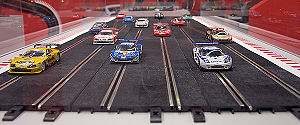
Description

Drivers generally use a hand-held controller to regulate a low-voltage electric motor
Electric motor
An electric motor converts electrical energy into mechanical energy.Most electric motors operate through the interaction of magnetic fields and current-carrying conductors to generate force...
hidden within the car. Traditionally, each car runs on a separate lane with its own guide-slot (though recently-developed digital technology can allow cars to share a lane). The challenge in racing slot cars comes in taking curves and other obstacles at the highest speed that will not cause the car to lose its grip and spin sideways, or to 'deslot', leaving the track altogether.
Some enthusiasts, much as in model railroading, build elaborate tracks, sculpted to have the appearance of a real-life racecourse, including miniature buildings, trees and people. Hobbyists whose main goal is competition often prefer a track unobstructed by scenery.
Model motorcycles, trucks and other vehicles that use the guide-slot system are also generally included under the loose classification of "slot car."
How it works
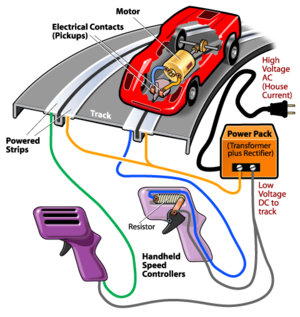
HO slot cars work on a similar principle, but the current is carried by thin metal rails that project barely above the track surface and are set farther out from the slot. The car's electrical contacts, called "pickup shoes", are generally fixed directly to the chassis, and a round guide pin is often used instead of a swiveling flag.
Today, in all scales, traction magnets are often used to provide downforce
Downforce
Downforce is a downwards thrust created by the aerodynamic characteristics of a car. The purpose of downforce is to allow a car to travel faster through a corner by increasing the vertical force on the tires, thus creating more grip....
to help hold the car to the track at higher speeds, though some enthusiasts believe magnet-free racing provides greater challenge and enjoyment and allows the back of the car to slide or "drift" outward for visual realism.
Common slot car scales

1:24 scale
1:24 is a very popular size for Die-cast toy vehicles, which are collected by children and adults. Primarily automobiles are made in this scale, with a few examples of tractor trailers and other larger equipment. Plastic automobile kits are frequently made in this scale.1:24 is the largest of the...
, 1:32 scale
1:32 scale
1:32 scale is a traditional scale for models and miniatures, in which one unit on the model represents 32 units on the actual object. It is also known as "three-eighths scale", since 3/8-inch represents a foot...
, and so-called HO size
HO scale
HO or H0 is the most popular scale of model railway in the world.According to the NMRA standard S-1.2 predominantly used in North America, in HO scale, represents 1 real foot ; this ratio works out to about 1:87.1. According to the MOROP standard NEM 010 predominantly used in Europe, the scale is...
(1:87 to 1:64 scale
1:64 scale
1:64 scale is a traditional scale for models and miniatures, in which one unit on the model represents 64 units on the actual object. It is also known as "three-sixteenths scale", since 3/16-inch represents a foot. A man is approximately 1-1/8 inches tall in 1:64 scale...
). These are also commonly written as 1/24, 1/32, 1/87 and 1/64. Usual pronunciation is "one twenty-fourth," "one thirty-second," and so on, but sometimes "one to twenty-four," "one to thirty-two," et cetera.
- 1:24 scale cars are built so that 1 unit of length (such as an inch or millimetre) on the model equals 24 units on the actual car. Thus, a model of a Jaguar XK-E (185" or 4.7 m overall length) would be 7.7" long (19.6 cm) in 1:24 scale
1:24 scale
1:24 is a very popular size for Die-cast toy vehicles, which are collected by children and adults. Primarily automobiles are made in this scale, with a few examples of tractor trailers and other larger equipment. Plastic automobile kits are frequently made in this scale.1:24 is the largest of the...
. 1:24 cars require a course so large as to be impractical for many home enthusiasts, so most serious 1:24 racing is done at commercial or club tracks.
- 1:32 scale cars are smaller and more suited to home-sized race courses but they are also widely raced on commercial tracks, in hobby shops or in clubs. This scale is the most popular in Europe, and is equivalent to the old #1 Gauge (or "standard size") of toy trains. Our Jaguar XK-E would be about 5.8" (14.7 cm) in 1:32 scale
1:32 scale
1:32 scale is a traditional scale for models and miniatures, in which one unit on the model represents 32 units on the actual object. It is also known as "three-eighths scale", since 3/8-inch represents a foot...
.
- HO-sized cars vary in scale. Because they were marketed as model railroad accessories, the original small slot cars of the early 1960s roughly approximated either American/European HO scale
HO scale
HO or H0 is the most popular scale of model railway in the world.According to the NMRA standard S-1.2 predominantly used in North America, in HO scale, represents 1 real foot ; this ratio works out to about 1:87.1. According to the MOROP standard NEM 010 predominantly used in Europe, the scale is...
(1:87) or British OO scale (1:76). As racing in this size evolved, the cars were enlarged to take more powerful motors, and today they are closer to 1:64 in scale; but they still run on track of approximately the same width, and are generically referred to as HO slot cars. They are not always accurate scale models, since the proportions of the tiny bodies must often be stretched to accommodate a standard motor and mechanism. The E-Jaguar scales out to 2.1" (5.3 cm) in 1:87 and 2.9" (7.3 cm) in 1:64). Though there is HO racing on commercial and shop-tracks, probably most HO racing occurs on home racetracks.
In addition to the major scales, slot cars have been commercially produced in 1:48 and 1:43 scale
1:43 scale
1:43 scale is an extremely popular size of die-cast model for adult collectors in Europe, Asia and the US. There are many manufacturers in this scale producing everything from customized and accurate race cars to emergency vehicles to family sedans and SUVs, including several making the...
, corresponding to O scale
O scale
O scale is a scale commonly used for toy trains and model railroading. Originally introduced by German toy manufacturer Märklin around 1900, by the 1930s three-rail alternating current O gauge was the most common model railroad scale in the United States and remained so until the early 1960s...
model trains. 1:48 cars were promoted briefly in the 1960s, and 1:43 slot car sets are generally marketed today (2007) as children's toys. So far, there is little organized competition in 1:43, but the scale is gaining some acceptance among adult hobbyists for its affordability and moderate space requirements. The E-Jag would be 4.3" (10.9 cm) in 1:43.
History
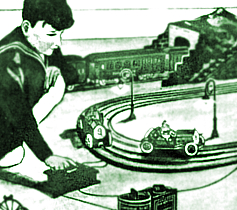
By the late 1930s, serious craftsmen/hobbyists were racing relatively large (1:16 - 1:18 scale) model cars powered by small internal combustion engines, originally with spark-ignition, later with glow plug
Glow plug (model engine)
A glow plug is a device, similar to a spark plug, used to help ignite the fuel in the very small internal combustion engines typically used in model aircraft, model cars and similar applications...
engines. For guidance, the cars were clamped to a single center rail, or tethered
Tether car
Tether Cars are model racing cars powered by miniature internal combustion engines and tethered to a central post. Unlike radio control cars, the driver has no remote control over the model's speed or steering.-Basics:...
from the center of a circular track, then they were started and let go for timed runs. There was no driver control of either the speed or steering, so "gas car" racing was largely a mechanic's hobby. In the 1940s hobbyists in Britain began to experiment with controllable electric cars using handbuilt motors, and in the 1950s using the small model train motors that had become available. In 1954, the Southport Model Engineering Society in the U.K. was challenged by a patent-holder for using rail-guided gas-car exhibitions to raise funds, so, as a replacement, the members constructed an electric racecourse, a groundbreaking 6-lane layout nearly 60 feet long, for 1:32 rail-guided cars, which is widely considered to be progenitor of electric rail- and slot-racing. In 1955-56, several clubs in the U.K. and U.S., inspired by the Southport layout, were also racing electric cars guided by center rails, and soon after, by slots in the track surface. The term "slot car" was coined to differentiate these from the earlier "rail cars". As the member-built club layouts proliferated, the relative advantages of rail and slot were debated for several years, but the obtrusive appearance of the rails and their blocking of the car's rear wheels when sliding through corners were powerful disadvantages. New clubs increasingly chose the slot system. By 1963, even the pioneer rail-racing clubs had begun to switch to slots.

Scalextric
Scalextric is a toy brand for a range of slot car racing sets which first appeared in the late 1950s, as a creation of British firm Minimodels. The brand is currently owned and distributed by Hornby.-History:...
line of slot-guided models, and Victory Industries (UK) introduced the VIP line, both companies eventually using the new plastic-molding technologies to provide controllable slot racers with authentic bodies in 1:32 scale for the mass market. Both lines included versatile sectional track for the home racer - or the home motorist; VIP produced sports cars and accessories slanted toward a "model roadways" theme, while Scalextric more successfully focused on Grand Prix racing.
As Scalextric became an instant hit, American hobbyists and manufacturers were adapting 1:24 car models to slots, and British-American engineer Derek Brand developed a tiny vibrator motor small enough to power model cars roughly in scale with HO and OO electric trains. In 1959, Playcraft division of Mettoy
Mettoy-Corgi
Corgi Toys is the name of a range of die-cast toy vehicles produced by Mettoy Playcraft Ltd. in the United Kingdom. The Mettoy company was founded in 1933 by German émigré Philip Ullmann in Northampton, England, where he was later joined by South African-born German Arthur Katz who had previously...
produced these in the UK, and a year later, Aurora Plastics Corp. released HO vibrator sets with huge success in the USA. The tiny cars fascinated the public, and their cost and space requirements were better suited to the average consumer than the larger scales. In only a year or two, Scalextric's 1:32 cars and Aurora's "Model Motoring" HO line had set off the "slot car craze" of the 1960s.
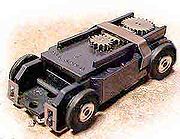
Commutator (electric)
A commutator is a rotary electrical switch in certain types of electric motors or electrical generators that periodically reverses the current direction between the rotor and the external circuit. In a motor, it applies power to the best location on the rotor, and in a generator, picks off power...
("pancake") motor, also created by Brand, and what is probably the best-selling slot car in history, the Aurora Thunderjet-500 was born. Faller (Germany) produced it for sale in Europe, and competing companies tried in vain to match the speed and reliability of Brand's design. The Thunderjets and their improved versions, the AFX, sold in the tens of millions, completely dominating the HO market for almost a decade, until challenged by the Tyco
Tyco Toys
Tyco Toys is an American toy manufacturer. Since 1997 it has been a division of the Mattel toy company.-History:Mantua Metal Products was a Woodbury Heights, New Jersey, metalworks business founded in 1926 by John Tyler and family...
cars in the early 1970s.
By the late 1970s the slot car boom was well over, the model train tie-ins and miniature motoring concepts largely forgotten, and the market returned to the more serious racing hobbyist, with local and national racing organizations evolving to set standards and rules for different classes of competition. Technological innovation brought much higher speeds in all scales, with faster motors, better tires, and traction magnets to hold the cars down in curves, though some of the '60s enthusiasts thought that slot racing had become too specialized for the casual hobbyist, and fondly remembered the more primitive cars of their youth as not so fast, but more fun.
In the 1990s, computer design and methods of printing on 3-D objects helped create much more detailed and authentic models than the simple shapes and rudimentary graphics of the slot car boom. In addition, newly manufactured replicas of Aurora's '60s and '70s HO slot cars appeared on the market and consumers gained the option of racing either the modern high-tech wondercars or the more basic designs of an earlier time. In 2004, the digital control
Digital Command Control
Digital Command Control is a standard for a system to operate model railways digitally. When equipped with Digital Command Control, locomotives on the same electrical section of track can be independently controlled....
systems which had revolutionized model railroading in the 1990s began to appear in 1:32 slot cars, offering the ability to race multiple cars per lane with more realistic passing.
Related systems and developments

Around 1962, AMT
Aluminum Metal Toys
Aluminum Model Toys, or AMT for short, was a Troy, Michigan based company that manufactured various pre-assembled plastic promotional models starting in 1948, when attorney West Gallogly, Sr. started it as a side business. Later, a variety of kits became very popular. Most of the company's vehicle...
's Turnpike system (USA) used multiple electrical pickups within the slot itself to allow drivers to control, to a limited extent, the steering of special 1:25 cars.
In the late 1960s the Arnold
Arnold (models)
Founded in 1906 by Karl Arnold in Nürnberg, K. Arnold & Co. began its life producing tin toys and related items. They produced an extensive line of model ships, doll house items and other toys. In 1935, K. Arnold & Co. hired Max Ernst as their managing director...
Minimobil system (Germany), also marketed as the Matchbox
Matchbox (toy company)
Matchbox is a popular toy brand which was introduced by Lesney Products in 1953 and is now owned by Mattel, Inc. The brand was so named as the original die-cast Matchbox toys were sold in boxes similar in style and size to those in which matches were sold...
Motorway (UK), used a long hidden coil, powered by trackside motors, to move die-cast or plastic cars down the track via a slot and detachable pin. Cars in different lanes could race, but cars in the same lane moved at the same speed, separated by a fixed distance.
In the mid and late 1970s several manufacturers including Aurora, Lionel and Ideal
Ideal Toy Company
Ideal Toy Company was founded as Ideal Novelty and Toy Company in New York in 1907 by Morris and Rose Michtom after they had invented the Teddy bear in 1903. The company changed its name to Ideal Toy Company in 1938...
(USA) introduced slotless racing systems that theoretically allowed cars to pass one another from the same lane. Most used a system of multiple power rails that allowed one car to speed up momentarily and move to the outside to pass. Though briefly successful as toy products, none of these systems worked well enough to be taken up by serious hobbyists.
In 2004, a number of traditional slot car manufacturers introduced digital control systems, which enable multiple cars to run in the same lane and to change lanes at certain points on the course. Digitally-coded signals sent along the power strips allow each car to respond only to its own controller.
In addition, imaginative manufacturers have used the slot track system to allow the racing of a variety of unusual things, including motorcycles, boats, airplanes, spacecraft, horses, fictional and cartoon vehicles, snowmobiles, futuristic railroad trains, and no doubt many more.
Slot car track
The first sectional slot tracks from Scalextric and VIP were molded rubber and folded metal, respectively, but modern slot tracks fall into two main categories: plastic tracks and routed tracks.Plastic Tracks are made from the molded plastic commercial track sections. Sectional track is inexpensive and easy to work with and the design of the course can be easily changed. The joints between the sections, however, make a rough running surface, prompting the derisive term "clickety-clack track." The many electrical connections cause voltage drop and contribute to more frequent electrical problems. For a permanent setup, the joints can be filled and smoothed, and the power rails soldered together or even replaced with continuous strips, but the surface is seldom as smooth as a good routed track.
Routed Tracks have the entire racecourse made from one or a few pieces of sheet material (traditionally chipboard or MDF
Medium-density fibreboard
Medium-density fiberboard is an engineered wood product formed by breaking down hardwood or softwood residuals into wood fibres, often in a defibrator, combining it with wax and a resin binder, and forming panels by applying high temperature and pressure...
, but sometimes polymer materials) with the guide-slots and the grooves for the power strips cut directly into the base material using a router
Wood router
A router is a tool used to rout out an area in the face of a relatively hard workpiece, typically of wood or plastic. The main application of routers is in woodworking, especially cabinetry....
or CNC machining. This provides a smooth and consistent surface, which is generally preferred for serious competition.
Electrical equipment
Power for most slot car tracks comes from a powerpack. Powerpacks contain a transformer, which reduces high voltage house current to a safe 12 to 20V (depending on car type), and usually a rectifier, which changes AC to DC, for cooler running and simpler motors. High-capacity lead-acid batteries are sometimes used for hobby slot cars. Toy race sets may use dry cell batteries at 3 to 6 volts.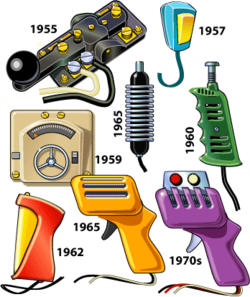
The early rail-car tracks used telegraph keys, model-train rheostats and other improvised means to control car speed. The first commercial race sets (1957) used handheld controllers with a thumb-button; like the telegraph key, these were either on or off, requiring the driver to "blip" the throttle for intermediate speeds. Later versions had an intermediate speed, and one late version used a buzzer mechanism to provide full-range speed control.
From 1959 to about 1965, most HO slot sets had a table-mounted controller with a miniature steering wheel or simple dial-knob operating a rheostat (variable resistor), which gave precise control throughout the car's speed range. This type could be left on a particular speed setting, making it very suitable for model highway layouts, but they were awkward for racing. Around 1960, handheld rheostats began to appear. Most early examples had vertical, thumb-operated plungers with the rheostat in the grip. Aurora had a plunger design in which a stack of carbon/silicon discs replaced the rheostat. Less common styles included a horizontal thumb-plunger and a full-grip squeeze controller. In 1965, Russkit introduced the trigger-operated pistolgrip controller. The pistolgrip quickly became the standard rheostat-controller style both for race sets and serious hobbyists, and has remained so to the present day. Control is by the index finger, and the heat-generating rheostat is above the grip for comfort and effective ventilation.
For good response, rheostats must be matched to the particular cars involved. To race different classes of cars, several controllers with different resistance ratings are often required. In the 1970s, electronic additions to the rheostat controllers became popular, which allowed them to be tuned to the particular car being raced. Some modern electronic controllers dispense with the rheostat altogether, and can be used for all classes and types of car. Digital slot cars generally use a controller that is trigger operated, though the rheostat housing is replaced by a slim bulge containing the electronics.
On most tracks, a driver will plug or clip his personal controller to his lane's "driver's station," which has wired connections to the power source and track rails. Modern controllers usually require three connections - one to the power terminal of the driver's station (customarily white), one to the brake terminal (red), and one to the track terminal (black). Conventional slot car tracks are wired in one of two ways: with the power terminal connected to the power source positive and the brake terminal negative (called "positive gate"), or the other way around ("negative gate"). Resistance type controllers can be used with either positive or negative track wiring, most electronic controllers can only be used with one or the other, although a few electronic controllers feature a switch that adapts them for either gate configuration.
Formal Competition
Slot car racing ranges from casual get-togethers at home tracks, using whatever cars the host makes available, to very serious competitions in which contestants painstakingly build or modify their own cars for maximum performance and compete in a series of races culminating in national and world championships. For information on types of formal competition, racing organizations, standards, etc., see slot car racing.Slot cars in popular culture
Film: Spotswood (AKA The Efficiency Expert, 1992). The Dukes of Hazzard. Slap Shot. Pulp Fiction. A Hard Day's Night. City Homicide. Grand Prix. Casino Royale. Redline 7000. Carry On Regardless. King Ralph. Rider on the Rain. Yours, Mine and Ours. Thunder Alley. Les Grande Vacancies. The Incredibles. The Persuaders. Twin Town. Record Breakers (1989).Television: The Simpsons. Batman. Tracey McBean on ABC kids. Home Improvement. Life at the Top. Danger Man (AKA Secret Agent). Mariah Carey's Touch my Body. Volvo ad (Sweden). VW Golf GTI ad. Swift cover ad 2011.
See also
- Armature (electrical engineering)Armature (electrical engineering)In electrical engineering, an armature generally refers to one of the two principal electrical components of an electromechanical machine–generally in a motor or generator, but it may also mean the pole piece of a permanent magnet or electromagnet, or the moving iron part of a solenoid or relay....
- List of model car brands
- Tether carTether carTether Cars are model racing cars powered by miniature internal combustion engines and tethered to a central post. Unlike radio control cars, the driver has no remote control over the model's speed or steering.-Basics:...
- Gasoline powered model cars which also run on guided tracks - InlineInline (slot car)In the model car hobby, an inline car is a type of slot car or other motorized model car in which the motor shaft runs lengthwise down the chassis, perpendicular to the driven axle . Power is transmitted through a pinion to a crown gear on the axle, or through bevel gears...
; PancakePancake (slot car)The pancake motor, as used in slot cars, is a type of electric motor, which has a flat commutator and vertical shaft. It was a feature of the highly successful Aurora HO slot cars of the 1960s and 1970s. The motor was not a separate unit; instead, its individual elements - magnets, armature,...
; SidewinderSidewinder (slot car)Sidewinder is a type of slot car or motorized model car in which the motor shaft is parallel to the driven axle , and power is transmitted through spur gears or, sometimes, a belt, friction or even by direct drive...
; AnglewinderAnglewinderAnglewinder is a type of slot car or motorized model car in which the motor shaft runs at an angle to the driven axle and drives it through a bevel or other angled gear arrangement. It is a development of the sidewinder, or transverse motor, in which the motor shaft is parallel to the driven axle...
- Types of slot car motors and motor arrangements.
External links
- A History of Slot Racing John Ford's short history of the hobby from the 1940s onward.
- Electric Rail Racing - Thoughts and History A memoir of rail racing and early slot times in Britain.

